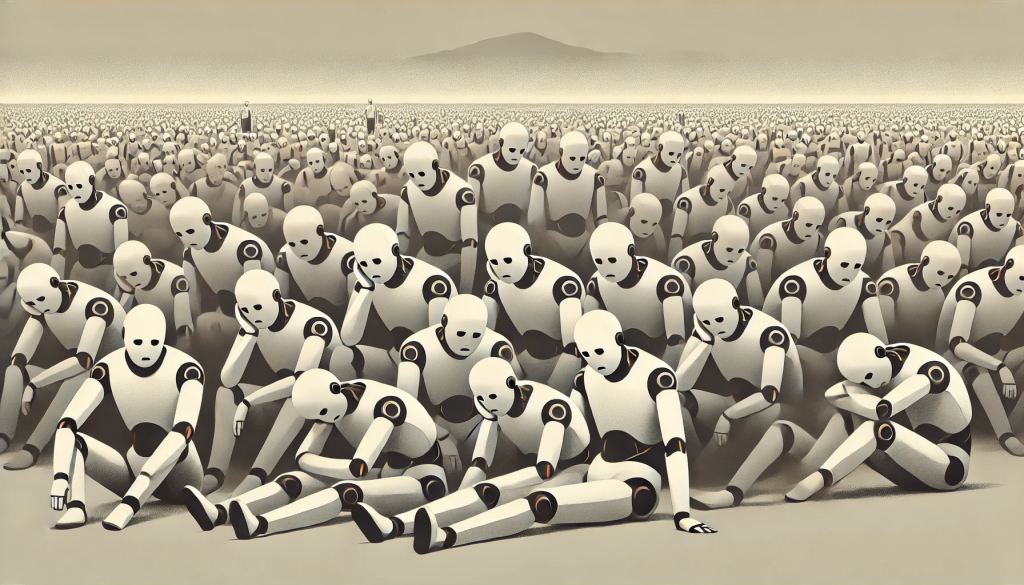In the fast-paced world of artificial intelligence, where every breakthrough could potentially change the fabric of society, there’s a lesser-known battle brewing within one of the industry's giants—OpenAI. The whispers of discontent, strife, and high-stakes turf wars echo through the hallways, giving rise to questions about leadership, employee satisfaction, and the very essence of innovation itself.
As OpenAI continues to evolve, it seems that the people behind the curtain are experiencing a different kind of turbulence—a reality check that transcends technical prowess. So, what’s really going on behind the scenes at OpenAI? Buckle up as we delve into the whirlwind of staff churn, management styles, and the unspoken struggles that might just be the biggest threat to the organization’s groundbreaking work.
The Cracks in the Foundation: Turf Wars and Leadership Dynamics
When Leadership Becomes a Battlefield
Last fall, the board of directors at OpenAI faced a crucial turning point. Sam Altman, the CEO known for his visionary approach to artificial intelligence, was coming under fire for his management style, particularly his penchant for creating competitive tensions among his leadership team. It’s the classic tale of a leader who sees their staff as players in a high-stakes game, rather than collaborators in a groundbreaking mission.
These tensions weren’t just petty office squabbles; they represented a significant threat to OpenAI’s ability to innovate and grow. Mira Murati, the Chief Technology Officer, found herself in the hot seat, fielding questions from board members concerned about the long-term implications of Altman’s methods. After all, in a startup environment that thrives on creativity and collaboration, pitting leaders against one another is a recipe for disaster.
The Cost of Competition
The competitive atmosphere cultivated by Altman may have initially seemed like a means to foster innovation, but the reality was more complicated. In a high-pressure environment where employees felt they were constantly vying for the spotlight, job satisfaction began to wane. Staff members found themselves not just battling external challenges, but also the internal politics that made their day-to-day work life feel like a constant struggle.
The Impact of Leadership Style on Retention
As discussions about retention heated up, it became increasingly clear that without a shift in leadership dynamics, OpenAI risked losing its most valuable assets: its people. With the talent war in full swing in the tech industry, other companies were ready to swoop in and snatch up skilled workers looking for a more supportive environment.
| Concern | Impact on Employees |
|---|---|
| Competitive leadership dynamics | Increased stress and burnout |
| Lack of collaboration | Decreased job satisfaction |
| High turnover rates | Loss of valuable knowledge |
Burnout: The Unseen Epidemic
The Price of Innovation
Innovation comes at a cost, and at OpenAI, that cost has manifested as burnout. In an environment that demands relentless creativity and breakthrough thinking, the pressure to perform can become overwhelming. This phenomenon is not unique to OpenAI; it reflects a larger trend within the tech industry, where the desire to stay ahead of the curve often leads to employees burning the candle at both ends.
Recognizing the Signs
Burnout can manifest in various forms, including emotional exhaustion, cynicism, and decreased performance. The combination of high expectations and a cutthroat work environment has led many employees at OpenAI to experience these symptoms firsthand. Those who were once eager to contribute to revolutionary projects found themselves disillusioned and disengaged.
The Human Cost of Burnout
The implications of burnout are dire—not just for employees, but for the organization as a whole. Research has shown that companies experiencing high levels of employee burnout face:
- Decreased Productivity: As employees struggle to cope, their output diminishes, affecting project timelines and innovation.
- Increased Turnover: High levels of burnout lead to employees seeking opportunities elsewhere, resulting in costly recruitment and training cycles.
- Lowered Morale: A culture of burnout can permeate an organization, leading to widespread dissatisfaction and a toxic work environment.
Taking Action
In response to the looming threat of burnout, OpenAI must prioritize employee well-being. This includes implementing measures such as:
- Flexible Work Arrangements: Allowing employees to work in ways that suit their individual needs can help alleviate stress.
- Mental Health Resources: Providing access to counseling and mental health support services can make a significant difference.
- Open Communication Channels: Fostering a culture where employees feel comfortable discussing their concerns can help prevent burnout before it escalates.
Compensation Demands: Money Talks
The Price of Talent
In a competitive landscape like tech, compensation is a hot-button issue. As OpenAI has grown, so have the demands from its workforce for fair and competitive pay. The need to attract and retain top talent is more pressing than ever, and organizations that fail to meet these demands may find themselves at a significant disadvantage.
Understanding Employee Needs
Employees at OpenAI are not only looking for monetary compensation; they seek recognition, respect, and validation for their contributions. When management fails to address these concerns, resentment builds. The disconnect between expectations and reality can lead to a further deterioration of morale and commitment.
Bridging the Gap
To foster a supportive work environment, OpenAI must evaluate and enhance its compensation strategies. This includes:
- Regular Salary Reviews: Ensuring salaries are competitive and reflective of industry standards.
- Transparent Communication: Clearly communicating the rationale behind compensation decisions fosters trust and respect.
- Equity Opportunities: Offering employees a stake in the company through stock options can align interests and encourage long-term commitment.
The Path Forward: Creating a Thriving Culture
Emphasizing Collaboration Over Competition
To navigate the challenges of leadership dynamics, OpenAI must shift its culture towards collaboration rather than competition. By fostering an environment where employees feel valued and empowered to work together, OpenAI can harness the full potential of its workforce.
Investing in Employee Well-Being
A company is only as strong as its employees. Investing in their well-being not only boosts morale but also enhances productivity. OpenAI can create a robust support system by prioritizing mental health initiatives and creating a flexible work environment.
Meeting Compensation Expectations
To attract and retain top talent, OpenAI must ensure that its compensation packages are competitive and reflective of the value its employees bring. By addressing concerns related to pay equity and transparency, the organization can build trust and loyalty among its workforce.
Conclusion: A Call to Action for OpenAI
The internal challenges facing OpenAI—turf wars, burnout, and compensation demands—are not insurmountable. By prioritizing collaboration, well-being, and fair compensation, OpenAI can create a thriving culture that attracts and retains top talent, ultimately driving innovation forward.
Join the Conversation
As we explore the complexities of workplace dynamics in high-stakes industries, it’s crucial to consider how we can collectively foster healthier work environments. What are your thoughts on OpenAI's challenges? How can organizations like OpenAI strike the right balance between innovation and employee well-being?
Become part of the iNthacity community, apply to become permanent residents or citizens of the "Shining City on the Web", and let us know your thoughts in the comments below!




















Post Comment
You must be logged in to post a comment.